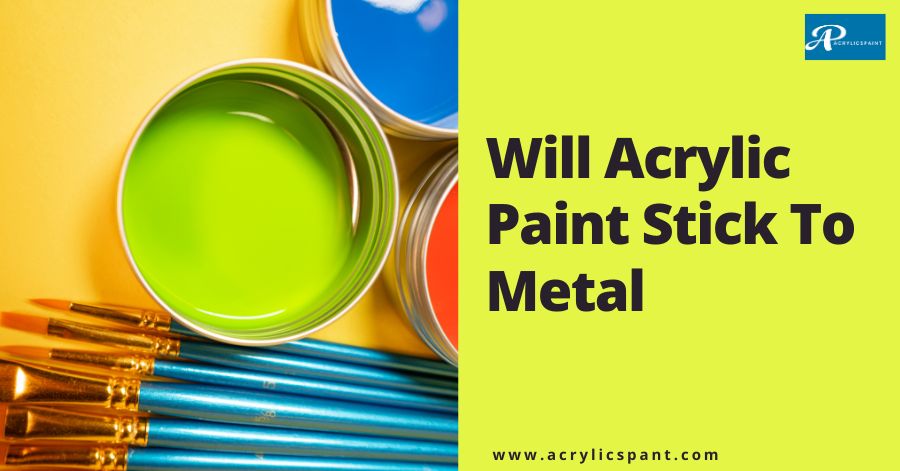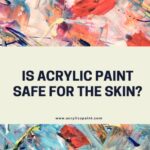Acrylic paint stick to metal – Have you ever looked at a bare metal surface and envisioned it bursting with vibrant colours or sporting a sleek, metallic finish? If so, you’re not alone. Painting metal surfaces is a fantastic way to breathe new life into old objects, create unique art pieces, or protect the metal from rust and corrosion. But when it comes to paint choices, a common question arises: can you use acrylic paint on metal?
Like most things in DIY, the answer is a nuanced “it depends.” While acrylic paint can adhere to metal to some extent, achieving a long-lasting, chip-resistant finish requires proper preparation and sometimes using a primer specifically designed for metal surfaces.
So, in this blog, we will guide you through deciding whether or not you can paint metal with acrylics, exploring the whys, hows, and everything in between to ensure your metallic masterpiece stands the test of time.
The Chemistry Behind Adhesion
With its water-based composition, acrylic paint tends to adhere well to porous surfaces like canvas and paper. However, metal surfaces pose a different challenge due to their smooth and non-absorbent nature. With proper priming, the paint can form a strong bond with the slick metal surface, leading to potential chipping, peeling, and paint failure.
Use primers for paint to stick on metal
The good news is that acrylic paint can be successfully used on metal surfaces. The key lies in priming metal before applying the paint. Primers bridge the paint and the metal, creating a slightly textured surface that allows the paint to adhere much better. Metal primers are specially formulated to withstand the expansion and contraction of metals due to temperature changes, further ensuring a durable finish.
Here are some of the best metal primers for a long-lasting, chip-resistant finish.
- Rust-Oleum Universal Bonding Primer
Rust-Oleum’s Universal Bonding Primer lives up to its name. This Primer boasts exceptional adhesion to various surfaces, including galvanized metal, aluminium, brass, and even PVC. It comes in a convenient spray paint can, making application a breeze. Plus, it dries fast and can be painted over with both acrylic and oil-based paints.
- Zinsser Bulls Eye 1-2-3 Primer
This high-quality Primer, a favourite among professionals, offers superior adhesion and corrosion resistance. Zinsser Bulls Eye 1-2-3 Primer works wonders on ferrous and non-ferrous metals, making it a great all-rounder. It’s available in both water-based and solvent-based versions.
- Krylon BOND Primer
Specially formulated for bonding to slick surfaces, the Krylon BOND Primer is a great choice for smooth metals like aluminium and stainless steel. This Primer offers excellent rust protection and comes in a user-friendly spray paint format.
- Evercoat Etch Primer
For maximum adhesion on bare or galvanized steel, consider Evercoat Etch Primer. This Primer contains mild etching properties that create a microscopic tooth on the metal surface, providing exceptional grip for the paint. However, due to its etching action, it’s recommended for experienced DIYers and requires proper ventilation during use.
- KILZ Adhesion High-Bond Primer
KILZ Adhesion High-Bond Primer is another top contender for its bonding strength. This Primer works well on various metals, including aluminium, copper, and galvanized steel. It’s available in both spray paint and brush-on.
How to prep the metal for acrylic paint and Acrylic paint stick to metal
Now that you understand the importance of priming metal let’s explore the different options available to paint metal with acrylic paint and its preparation:
Metal Primer for Acrylic Paint
This is the most straightforward and recommended approach. Look for primers labeled explicitly for use with acrylic paints on metal surfaces. These primers often come in spray paint cans or brush-on varieties, making application a breeze.
Self-Priming Acrylic Paints
While less common, some acrylic color manufacturers offer self-priming options. These paints claim to eliminate the need for a separate primer coat. However, their effectiveness might vary depending on the metal type and the desired durability. Always test a small area before committing to a whole project.
Priming Tips for a Flawless Finish
- Cleanliness is Key: Thoroughly clean the metal surface before applying Primer or paint. Remove dirt, grease, and rust using a degreaser or a mild abrasive cleaner. Rinse well and allow the metal to dry completely.
- Sanding for Better Bonding: Lightly sand the metal surface with fine-grit sandpaper for extra adhesion. This creates microscopic scratches that enhance the Primer’s ability to grip the metal.
- Follow the Instructions: Different primers have varying drying times and application recommendations. Ensure you follow the specific instructions on the product label for optimal results.
Can You Use Acrylic Paint on Metal Without Primer?
Yes, you can apply acrylic paint directly to metal. However, as mentioned earlier, this approach is not recommended for long-lasting projects. The paint is more prone to chipping, peeling, and wear and tear without a primer.
Here are some scenarios where skipping the Primer might be a calculated risk:
Temporary Applications
You can skip the priming option if you paint a metal surface for a short-term project, like a school art project or a decorative piece you occasionally handle. Not using primers can cause your paint to flake in the future.
Certain Non-Ferrous Metals
Metals like aluminium, brass, and copper generally have better natural adhesion properties than ferrous metals like iron and steel. In some cases, you might get away with using acrylic paint directly on these metals, especially for small, low-traffic projects. However, priming is always recommended for best results.
Choosing the Right Paint for Metal Art
Acrylics work on metal, but there are special metal paints too! Let’s see the difference.
- Acrylic Paint: Affordable, versatile, and easy to use, but requires proper priming for optimal adhesion on metal.
- Enamel Paint: Offers excellent durability and weather resistance, making it a good choice for outdoor projects. However, enamel paints have a strong odor and require mineral spirits for cleanup.
- Metal sticky Paints: Specially formulated for use on metal, these paints often come with built-in
Conclusion
In conclusion, the question, “Can acrylic paint stick to metal?” receives a resounding affirmative answer when approached with the proper techniques and tools. Artists can unlock a world of creative possibilities by priming metal surfaces and employing proper painting and sealing techniques. Whether crafting metal art pieces or adding flair to functional items, acrylic paints offer endless opportunities for expression on metal surfaces.














